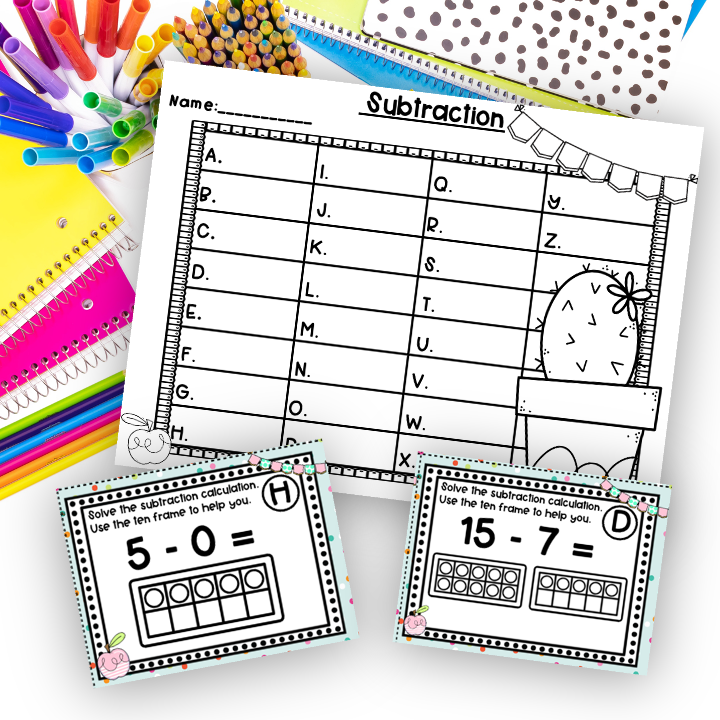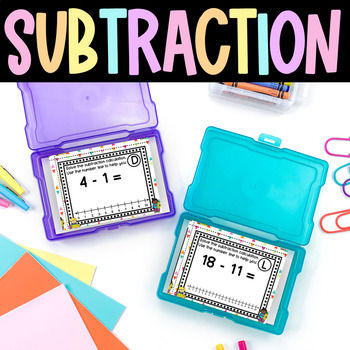How to Teach Subtraction in Kindergarten?
- gmmcooney
- May 25, 2023
- 7 min read
Updated: Jun 27, 2023

Teaching subtraction can be notoriously more challenging than teaching addition. For some students, it just doesn’t come as naturally as what addition does!
In this blog post I am going to talk about why children should learn subtraction and how it relates to real life. I am also going to explore different strategies of teaching subtraction as well as some difficulties your students may face. There will be different activity ideas for teaching subtraction for you to try out too!
Do you want some free Math resources? Sign up here to receive a free Math Early Skills Pack, perfect for assessing a range of your student’s math skills all year round. After signing up, you will be the first to learn about my new teaching resources, teacher tips and blog posts making sure you always have fun teaching ideas all year round! Click here to sign up!
What is subtraction?
Simply put, subtraction is the process of taking one quantity or number away from another and finding what is left. Subtraction is the opposite of addition and is usually written with the minus sign (-). You may see subtraction represented using different vocabulary especially when working with subtraction word problems. It is important that your students become familiar with the different ways of saying subtraction. You may come across terms like “taking away”, “minus”, “decrease”, “deduct” or “find the difference”. That last one always confused my students so it would be beneficial to ensure your kids know what they mean.
How do you relate subtraction to real life?
Subtraction helps children to understand and associate numbers with objects and further develops their number sense. Subtraction is important to learn as it will allow students to function well in real life. We use subtraction when dealing with money, cooking, travel times and many other day to day aspects.

What age should kids learn subtraction?
Students usually begin to learn subtraction between the ages 5 and 7, but some children may be different. Students need to have the adequate number sense first and should be able to count accurately. If a child can count to 10, they are ready learn subtraction within 10. Usually, students will have learned how to add first, then will be ready to move onto subtraction.
What is the easiest way to explain subtraction?
A suitable way, would be to explain and demonstrate that subtraction is the opposite of addition. Visually show “taking away” using concrete materials and show how the amount left will always be less than what we started with.
What are the strategies to teach subtraction?
With younger students, it is a good idea to start off using concrete materials. Ask students to count out a number of cubes, counters etc, then physically show your students taking away a certain number of objects. Ask children to count how many are left. This would also be a good time to introduce how to write a subtraction problem or calculation. Explain that we always start with the larger number and introduce the minus symbol.
Once confident using concrete materials, your students can move onto using visuals such as pictures, ten frames etc. Doing this means children still have something to count that is in front of them. Ask students to look at the number of pictures you are starting with but this time to represent the “taking away” action, your kids can cross out the quantity they are subtracting, then count how many are left.
Next, you can introduce subtracting on a number line. As your students will be already familiar with adding on a number line, they may get confused here. Ensure to spend a lot of time explaining what number to start on, which way to jump to subtract and that the number we land on is the answer.
Now, your class can practise mentally subtracting. You could explain that your students could count back, however a lot of students may struggle with this. Another method would be explaining how to count on. If we start on the smaller number and count on until we reach the larger number, it is the same as finding the difference and will give us the correct answer to our subtraction problem. It would be a good idea to use a number line here to help your students visualise this.
Just like with addition, we can now show how to represent subtraction using the Part Part Whole model. Ensure to explain where we place each number in the model as this will be different when adding.
This leads us on to number bonds. If your students are confident at using the Part Part Whole model to represent subtraction, they can easily link this to number bonds up to 5, 10, 20 etc depending on where your students are in their learning.
Next, your students can practise subtraction using word problems. Ensure to spend time picking out the key information from the word problem as well as the different vocabulary that may be used.
Tips for teaching subtraction in kindergarten
Give your students lots of opportunities to use concrete materials and visuals.
Spend time talking about the vocabulary – subtraction, taking away, find the difference etc.
Explore different strategies – number line, visuals, part part whole etc.
Spend time on word problems.
Link it real life – this can be done through word problems.
Set up independent activities around your classroom to give children lots of practise.
Make subtraction fun!
How do you make subtraction fun?
When teaching subtraction to your students you can keep it fun and engaging by using various strategies and hands on activities.
Concrete materials & visuals – set up areas in your classroom for children to practise reading subtraction problems and working out answer. This can be done with cubes, counters, loose parts etc. It would be a good idea to use word problems here too! If your children need support with reading you can even use small battery powered recording devices to record you saying the math problem that your students need to work out. Your class can also practise subtraction in Math centers with an adult using task cards.

Number lines – You can start off with a giant number line maybe drawn in the playground or on a large strip of paper and children can physically practise jumping backwards on the number line. This will really help them understand the movement of jumping backwards on the number line. Then they can move onto using resources such as worksheets, task cards and things they can draw jumps onto so they can still visualise the jumps. When ready, your class can move onto using their finger or a counter to do jumps on a number line. These kinds of activities can be set up in your classroom or used as a Math center.
Part Part Whole Model – Using large Part Part Whole diagrams, you can count out the number of counters etc that you are starting with and place these in the largest part of the Part Part Whole model. You can then show taking away an amount by putting it into one of the smaller sections of the diagram. Then push what is left into the other smaller section. This helps your students to visualise partitioning a number into two parts. After exploring this with concrete materials you can then move onto writing the numbers into the correct sections of the Part Part Whole model.
Word problems – Exploring subtraction word problems can be done with the whole class. You can even act out word problems using props or concrete materials. Your students can then move onto independent activities in your classroom or as a math centre. Task cards can be used as independent activities, or you can record subtraction word problems on small recording devices for your students to solve.

How do you explain find the difference?
Ensure to spend time explaining that finding the difference is a form of subtraction. The goal is to find how many numbers lie between two given numbers. You can show that if you start off with smaller number and count on until reach the larger number, the number of jumps between these two numbers is finding the difference.
Why do children struggle with subtraction?
There are numerous reasons why some students struggle with subtraction.
Children can sometimes get mixed up with addition. As your students learned addition first it is almost an instinct to add rather subtract. You may notice this when using a number line as your children’s first step would normally be to jump up the number line. It can take a lot of getting used to doing it the other way and jumping backwards.
Another difficulty students may encounter is if they are not confident with their addition facts or number bonds. If they are confident with these, this will greatly help with subtraction. As it is just the other part of same the calculation. This skill is what is being developed when we are exploring the Part Part Whole model. Revising number bonds and addition facts will help here.
Students not having appropriate number sense can be another difficulty they may face. Children need to be confident with counting to 5, 10 or 20 depending on what numbers they are working with when subtracting. Students need to be able to accurately count out the number they are starting with and accurately take away the correct number as well as count what is left. Your class will also need good number sense when figuring out what number to begin with (the larger number) and know that their answer should be less than what they started with. An excellent way to develop number sense is giving your class lots of opportunities to count and explore number sequencing.
Overall, subtraction is usually a trickier concept for your children to grasp as it does not come as naturally as addition.
Keep in mind there are many different subtraction strategies to explore and that some children may find one strategy easier than others.
Remember to keep your students engaged by giving them lots of opportunities to explore subtraction using concrete materials and that exploring the vocabulary of subtraction will be well worth it!














Comments